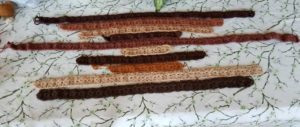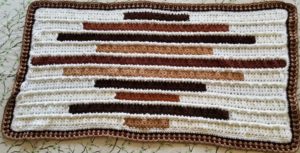Last week, I introduced you to Jeannie Taylor and the lap robe she created using the strips of crochet she found in a bag of donated yarn. I promised to share her pattern with you. I hope it will encourage you to listen to those nudges and ideas from God. I hope it will inspire you to create lovely and comforting patterns with the “scraps of beauty” in your own or your prayer shawl group’s yarn stash.
Here is the pattern and the story of the lap robe, in Jeannie’s own words:

“This is what I found in a bag of yarn that was donated to the Prayer Shawl Ministry of Grace Lutheran Church in Pensacola, FL.
I looked at these 10 pieces, all in different lengths, and laid them out on the table. God’s still, small voice said to me: “Those would make a neat abstract lap robe, Jeanie.” So, I listened.
I knew I’d need to make all the strips the same length, so I counted the number of shell stitches in the longest strip. Then I made a hand-written spreadsheet, listing the color of the strips and the number of shell stitches in each strip. I did the math to see how many shells I’d have to crochet at the top and bottom of each strip to make them as long as the longest strip.
Thinking I’d like to use a cream-colored yarn to do this, I brought out the cream yarn, but didn’t like it. White yarn was the best in the end.
Adding onto the bottom of the strip meant crocheting shells in white to a given point, with the challenge of how to attach it to the colored strip being an issue. But I did it, after a few tests. Adding onto the top of each strip was easy.
As each strip was made to the proper length, it was bordered, making sure that each strip had the same number of stitches lengthwise. Then, I laid the strips out in several ways to determine the best abstract design.
I placed paper markers numbered from 1-10 on the bottom end of each strip to make sure I’d keep the strips in the correct abstract design order. Then I placed two markers at the top and the bottom of each strip to designate the 6-stitches that would be considered the top and bottom of each strip. Then I crocheted the strips together, placing a Double Picot Single Crochet & Granule Stitch (DPSC&GS) in every sixth stitch down the length of each strip. The DPSC&GS is like a popcorn stitch, but it stands up straight. Each strip had to have the same number of DPSC&GS stitches, and they needed to be in the same place as the previous strip and across the lap robe.
Once all the strips were attached, I crocheted and extra border of white then five more complementary borders around the entire lap robe from leftover yarns I had in another bag.”
In a later email, Jeannie passed on some helpful information on the stitch she used to join the strips, the Double Picot Single Crochet and Granule Stitch. She found instructions (both photo and video) for the Single Crochet and Granule Stitch on Moogly in the Tutorial section under Advanced Stitches. She says, “I changed the Picot Single Crochet and Granule Stich to a Double Picot Single Crochet and Granule Stitch by making 2 Ch3s and pulling through 2 loops on the hook, then slip stitching in the same stitch.”
And here is the result of Jeannie’s creativity and innovation:

I would love to see how other prayer shawl makers have used “scraps of beauty” to make unique and beautiful shawls and lap robes. As one of my readers, Pam Briden, says, “Usually they are the ones that turn out best.”

Recent Comments